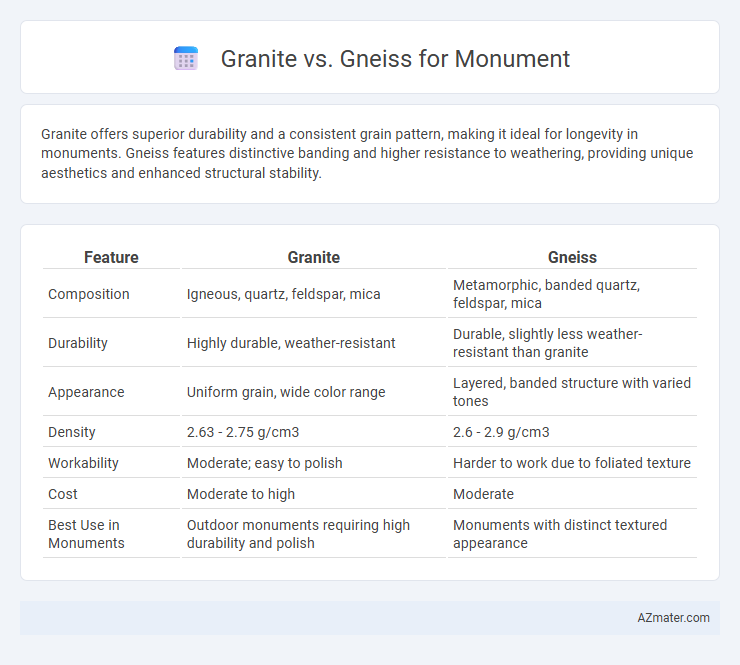Granite offers superior durability and a consistent grain pattern, making it ideal for longevity in monuments. Gneiss features distinctive banding and higher resistance to weathering, providing unique aesthetics and enhanced structural stability.
Table of Comparison
| Feature | Granite | Gneiss |
|---|---|---|
| Composition | Igneous, quartz, feldspar, mica | Metamorphic, banded quartz, feldspar, mica |
| Durability | Highly durable, weather-resistant | Durable, slightly less weather-resistant than granite |
| Appearance | Uniform grain, wide color range | Layered, banded structure with varied tones |
| Density | 2.63 - 2.75 g/cm3 | 2.6 - 2.9 g/cm3 |
| Workability | Moderate; easy to polish | Harder to work due to foliated texture |
| Cost | Moderate to high | Moderate |
| Best Use in Monuments | Outdoor monuments requiring high durability and polish | Monuments with distinct textured appearance |
Introduction to Granite and Gneiss
Granite, an igneous rock composed mainly of quartz, feldspar, and mica, is prized for its durability and polished finish in monument construction. Gneiss, a metamorphic rock characterized by its distinct banding and high resistance to weathering, offers unique aesthetic patterns that make it a popular alternative. Both stones provide exceptional longevity and strength, essential qualities for monuments exposed to outdoor elements.
Geological Formation of Granite and Gneiss
Granite forms from the slow crystallization of magma beneath the Earth's surface, resulting in a coarse-grained, igneous rock composed primarily of quartz, feldspar, and mica. Gneiss originates from high-grade metamorphism of pre-existing rocks, often granite or sedimentary rocks, undergoing intense heat and pressure that re-aligns minerals into distinctive banded patterns. The contrasting geological formation processes contribute to granite's uniform texture and gneiss's foliated structure, impacting their durability and aesthetic qualities for use in monuments.
Physical Characteristics Comparison
Granite features a coarse-grained texture composed primarily of quartz, feldspar, and mica, resulting in high hardness and durability ideal for monuments exposed to weathering. Gneiss, characterized by its distinct banded or foliated structure formed through high-grade metamorphism, offers variable hardness with pronounced mineral alignment that can impact its structural integrity over time. Both stones display excellent compressive strength, but granite's uniform grain pattern provides greater resistance against erosion, making it a preferred choice for long-lasting monumental applications.
Durability and Weather Resistance
Granite exhibits exceptional durability and superior weather resistance, making it a preferred choice for monuments exposed to harsh environmental conditions. Gneiss, while also durable, tends to have a more foliated structure that may increase susceptibility to weathering and erosion over time. The dense, interlocking crystalline composition of granite provides enhanced strength and longevity, ensuring monuments maintain their appearance and structural integrity for centuries.
Aesthetic Differences: Colors and Patterns
Granite features a more uniform pattern with speckled, coarse-grained textures, commonly displaying colors like pink, gray, white, and black, making it ideal for monuments requiring a classic and polished appearance. Gneiss exhibits distinct banding with alternating light and dark mineral layers, offering a more dramatic, striped aesthetic often in shades of gray, black, and white, providing monuments with a striking and natural look. The choice between granite and gneiss depends on whether a smooth, consistent look or a bold, textured pattern is preferred for the monument's visual impact.
Workability and Sculpting Potential
Granite offers excellent workability and sculpting potential due to its uniform grain structure and hardness, allowing for precise detailing and smooth finishes on monuments. Gneiss, with its foliated texture and varying mineral bands, presents challenges in sculpting but provides unique aesthetic patterns that enhance monument designs. Sculptors favor granite for intricate carvings, while gneiss is chosen for its natural, textured appearance in larger or less detailed elements.
Cost and Availability of Each Stone
Granite is generally more cost-effective for monuments due to its widespread availability and ease of quarrying compared to gneiss, which is rarer and often available in limited quantities, driving up its price. Granite's durability and uniform texture make it a preferred choice for large-scale monuments, whereas gneiss, with its foliated structure, may require more specialized cutting and polishing, increasing labor costs. Regional availability heavily influences the final expense, as granite deposits are globally abundant, whereas gneiss occurrences are more geographically restricted.
Maintenance Requirements
Granite requires minimal maintenance due to its dense, non-porous structure, resisting stains and weathering, making it ideal for long-lasting monuments. Gneiss, although durable, features a foliated texture that can harbor moisture and dirt, necessitating more frequent cleaning and sealing to prevent erosion and discoloration. Both stones benefit from periodic inspections, but granite's low porosity significantly reduces upkeep compared to the more porous gneiss.
Famous Monuments Made from Granite and Gneiss
Granite, known for its durability and coarse-grained texture, is famously used in monuments like Mount Rushmore National Memorial and the Red Pyramid of Dahshur, showcasing its ability to withstand weathering and time. Gneiss, a metamorphic rock with distinct banding patterns, is featured in historic structures such as the Russian Kremlin walls and parts of the ancient city of Petra, where its foliation enhances the aesthetic appeal. Both stones provide unique visual and structural qualities, influencing the choice of material in monumental architecture and sculpture.
Choosing the Best Stone for Monuments
Granite offers exceptional durability, resistance to weathering, and a granular texture that makes it ideal for monuments exposed to harsh environmental conditions. Gneiss, while also durable, features a foliated structure that may influence its structural integrity over time, though its unique banding adds aesthetic appeal. Selecting the best stone for monuments depends on prioritizing factors such as longevity, maintenance, and desired visual effect, with granite often favored for its strength and gneiss chosen for its distinctive appearance.

Infographic: Granite vs Gneiss for Monument
 azmater.com
azmater.com